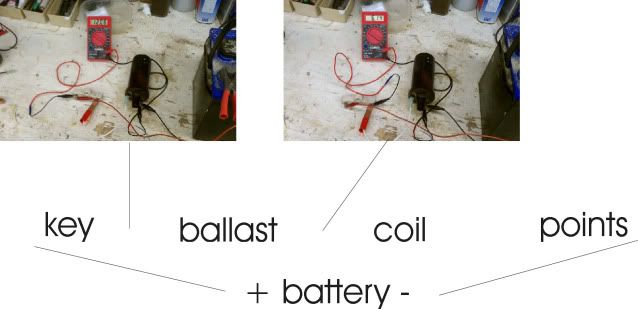NOTE: This thread was started by moving this post and a couple following from THIS THREAD to here.
Don S.
OK - I've learned that an electronic ignition can run a coil that requires ballast even without the ballast - and that makes sense. But doesn't my original statement still hold - a coil that requires ballast should not be run on 12 volts?
I admit, I didn't go to boat school or have any formal training on the subject, but I do mess with stuff a lot on the boat and on the bench. Here's how my boat is wired with a pic of the ballast and coil I took off, hooked up to a battery.
When I switch on the key, 12 volts goes to the ballast - whether the points are open or closed.
On the coil side of the ballast with the key on, I have about 6 volts. To me, this means that the coil is designed for +/-6 volts, not 12. While cranking, the ballast is bypassed because the starting current can pull the battery voltage down to 9 volts or less. So the coil still gets at least the 6 volts it needs to make spark.
I may not be thinking correctly, but if I take the ballast out of the picture, I'll be giving that '6 volt' coil 12 volts all the time and it's bound to heat up or blow, otherwise why the ballast?

Don S.
I now the OP doesn't have a points ignition but this needs to be cleared up. Even if he had a points system this would only be true if the points were closed. With the points open, you would measure 12V no matter if a ballast resistor was in there or not.
OK - I've learned that an electronic ignition can run a coil that requires ballast even without the ballast - and that makes sense. But doesn't my original statement still hold - a coil that requires ballast should not be run on 12 volts?
I admit, I didn't go to boat school or have any formal training on the subject, but I do mess with stuff a lot on the boat and on the bench. Here's how my boat is wired with a pic of the ballast and coil I took off, hooked up to a battery.
When I switch on the key, 12 volts goes to the ballast - whether the points are open or closed.
On the coil side of the ballast with the key on, I have about 6 volts. To me, this means that the coil is designed for +/-6 volts, not 12. While cranking, the ballast is bypassed because the starting current can pull the battery voltage down to 9 volts or less. So the coil still gets at least the 6 volts it needs to make spark.
I may not be thinking correctly, but if I take the ballast out of the picture, I'll be giving that '6 volt' coil 12 volts all the time and it's bound to heat up or blow, otherwise why the ballast?

Last edited by a moderator:



















